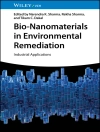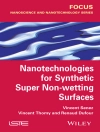This is the first monograph to specifically focus on fundamentals and applications of polyelectrolytes, a class of molecules that gained substantial interest due to their unique combination of properties. Combining both features of organic semiconductors and polyelectrolytes,
they offer a broad field for fundamental research as well as applications to analytical chemistry, optical imaging, and opto-electronic devices.
The initial chapters introduce readers to the synthesis, optical and electrical properties of various conjugated polyelectrolytes. This is followed
by chapters on the applications of these materials in optical sensing and imaging with emphasis on biological systems, while the final
section addresses the emerging applications of conjugated polyelectrolytes in optoelectronic devices, concluding with an in-depth discussion
of structure-property relationship.
The editors and contributors are all pioneers and experts in this expanding field. This monograph is not only for chemists, materials
scientists, and physicists, but also a unique source of knowledge for readers with scientific background interested in polyelectrolytes.
Daftar Isi
PREFACE
DESIGN AND SYNTHESIS OF CONJUGATED POLYELECTROLYTES
Introduction
Poly(arylene)s
Poly(arylene ethynylene)s
Poly(arylene vinylene)s
Conclusion
ALL-CONJUGATED ROD-ROD DIBLOCK COPOLYMERS CONTAINING CONJUGATED POLYELECTROLYTE BLOCKS
Introduction
All-Conjugated, Cationic Polyfluorene-b-Polythiophene Diblock Copolymers
All-Conjugated Cationic Polyfluorene-b-Polyfluorene Diblock Copolymers
Conclusion
IONICALLY FUNCTIONALIZED POLYACETYLENES
Introduction
Polymers from Ionically Functionalized Cyclooctatetraenes
Polymers from Ionically Functionalized Acetylenes
Summary
AGGREGATION PROPERTIES OF CONJUGATED POLYELECTROLYTES
Introduction
Aggregation: from Disordered Clusters to Structured Vesicles
Experimental Studies on Aggregation
Conjugated Polyelectrolyte Aggregation in Solution
Learning How to Control Aggregation
Conclusions and Outlook
SENSING VIA QUENCHING OF CONJUGATED POLYELECTROLYTE FLUORESCENCE
Background and Introduction
Small Ions/Molecules Sensing
Protein and Enzyme Activity Sensing
DNA sensing
Concluding Remarks
SENSING APPLICATIONS VIA ENERGY TRANSFER FROM CONJUGATED POLYELECTROLYTES
Introduction
DNA and RNA Sensing with Conjugated Polyelectrolytes
Protein Sensing with Conjugated Polyelectrolytes
Biological/Chemical Small-Molecules Sensing with Conjugated Polyelectrolytes
Conclusion
SENSING VIA CONFORMATIONAL CHANGES OF CONJUGATED POLYTHIOPHENES
Introduction
Structural Characteristics of Conjugated Polythiophenes
Thermochromic Sensors
Ionochromic Sensors
Affinitychromic Sensors
Conclusions
CONJUGATED POLYELECTROLYTE-BASED BIOCIDE APPLICATIONS
Introduction
Dark Bactericidal Activity of Conjugated Polyelectrolytes
Light-Activated Biocidal Activity
Photochemistry, Photophysics, and Modeling
Conjugated Cationic Oligomers and Polymers as Antimicrobials
Incorporation into Other Materials and Formats
Activity against Viruses and Biofilms
Toxicity toward Mammalian Cells
Summary and Outlook
CONJUGATED POLYELECTROLYTE-BASED IMAGING AND MONITORING OF PROTEIN AGGREGATION
Introduction
CPEs for Bioimaging
Amyloid Fibrils and Protein Aggregation Diseases
Novel Scaffolds for the Detection of a Diversity of Protein Aggregates
Conclusion
CHARGE INJECTION MECHANISM IN PLEDS AND CHARGE TRANSPORT IN CONJUGATED POLYELECTROLYTES
Introduction
Charge Injection Mechanism in Polymer Light-Emitting Diodes Using Conjugated Polyelectrolytes as Electron-Injecting/Transporting Layers
Charge Transport in Conjugated Polyelectrolytes
Conclusion
ORGANIC OPTOELECTRONIC DEVICES CONTAINING WATER/ALCOHOL-SOLUBLE CONJUGATED POLYMERS AND CONJUGATED POLYELECTROLYTES
Introduction
Polymer Light-Emitting Devices Based on Water/Alcohol-Soluble Conjugated Polymers and Conjugated Polyelectrolytes
Water/Alcohol-Soluble Conjugated Polymers as Efficient Electron Injection/Transport Layer in PLEDs
Water/Alcohol-Soluble Conjugated Polymers/Polyelectrolytes as Cathode Interlayer for Polymer Solar Cells
Applications of Water/Alcohol-Soluble Conjugated Polymers and Conjugated Polyelectrolytes in Other Optoelectronic Devices
Summary
Conclusion
OPTICAL PROCESSES IN CONJUGATED POLYELECTROLYTES DEPENDENCE ON CHAIN CONFORMATION AND FILM MORPHOLOGY
Introduction
Hydrophobic and Electrostatic Interactions in CPEs
Amphiphilic CPEs and CPE-Surfactant Complexes: toward Ordered Structures and Controlled Photophysics at the Solid State
Photoluminescence Quenching in CPEs: Fast Exciton Dynamics
Effect of the Ion and Counterion Choice on the CPE Photoluminescence
Nature of the Excited States: Charge-Transfer States and Polarons in CPEs
Conclusions
INDEX
Tentang Penulis
Bin Liu is Associate Professor in the Department of Chemical and Biomolecular Engineering, National University of Singapore (NUS). Her research focuses on the development of water-dispersable conjugated polymers with explorations on their sensing, imaging and device applications. She has over 130 scientific publications and has received several awards including the NUS Young Investigator Award,
Singapore National Science and Technology Young Scientist Award and L?Oreal-Singapore Women in Science National Fellowship.
Guillermo C. Bazan is Professor of Chemistry and Biochemistry at the University of California, Santa Barbara. He has over 300 publications and an H-index of 72. Much of his work is centered on the applications of conjugated polyelectrolytes in biosensing technologies and the fabrication of optoelectronic devices. Guillermo Bazan’s awards and recognitions include the 2006 ACS Cope Scholar Award, the 2005 Bessel
Award and the 2003 National Science Foundation Special Creativity Award. In addition, he serves as a member of the editorial advisory boards of Macromolecules and Advanced Materials.












